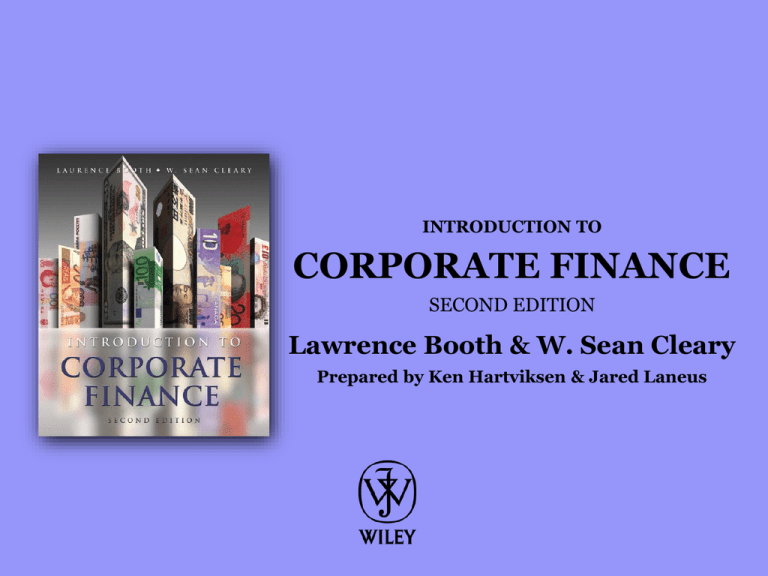
INTRODUCTION TO
CORPORATE FINANCE
SECOND EDITION
Lawrence Booth & W. Sean Cleary
Prepared by Ken Hartviksen & Jared Laneus
Chapter 3
Financial Statements
3.1 Accounting Principles
3.2 Organizing a Firm’s Transactions
3.3 Preparing Accounting Statements
3.4 Tim Horton’s Inc. Accounting Statements
3.5 The Canadian Tax System
Booth/Cleary Introduction to Corporate Finance, Second Edition
2
Learning Objectives
3.1 Describe what generally accepted accounting principles are
and their significance and implications for a firm.
3.2 Organize a firm’s transactions, and explain what are the
most important accounting principles related to this task.
3.3 Prepare a firm’s financial statements.
3.4 Analyze a firm’s financial statements.
3.5 Describe the Canadian tax system and explain the
differences between how a corporation and an individual are
taxed.
Booth/Cleary Introduction to Corporate Finance, Second Edition
3
Accounting Principles
• Accounting is an organized way of summarizing the activities of
business.
• Internal and external users of accounting information rely on it to make
decisions.
• Financial managers require a strong understanding of accounting
because they use that information to make significant decisions that
will affect the firm.
• Generally Accepted Accounting Principles (GAAP) are contained in the
CICA Handbook and have the force of law in Canada
• The Income Tax Act (ITA) requires the use of the CICA Handbook, except
where specifically the Act requires other treatment. This has led to the
practice of Canadian firms reporting to shareholders using CICA GAAP
and preparing separate financial statements for CRA.
• Reporting of financial performance in a consistent manner over time
and between firms enhances the usefulness of those reports, allowing
comparative analysis.
4
Booth/Cleary Introduction to Corporate Finance, Second Edition
International Convergence
• Different countries have different accounting standards set
by professional organizations that regulate the profession:
• Canada: CICA, the Canadian Institute of Chartered
Accountants
• USA: FASB, Financial Accounting Standards Board
• Japan: ASBJ, Accounting Standards Board of Japan
• Given the growing importance of international trade and the
integration of product and financial markets, there is a need
for countries to move to a common set of accounting
standards.
• The London-based International Accounting Standards Board
(IASB) has been working to achieve a common standard.
Booth/Cleary Introduction to Corporate Finance, Second Edition
5
Impact of Recent Accounting Scandals
• The Enron bankruptcy, in addition to other scandals
involving WorldCom, Tyco. and others demonstrate the need
for reform.
• Since investors use accounting information to make investing
decisions and value firms, recent accounting scandals where
financial statements were misleading have caused investors
to lose confidence in financial markets.
• The U.S. Congress passed the Sarbanes-Oxley Act (SOX) in
2002 in an attempt to restore investor confidence by
imposing new requirements for financial disclosure and
oversight.
Booth/Cleary Introduction to Corporate Finance, Second Edition
6
Main Provisions of Sarbanes-Oxley (2002)
• A new Public Company Accounting Oversight Board
• Register and inspect public accounting firms
• Establish audit standards
• Separation of the audit function from other services provided by
auditing firms
• Improved standards for corporate governance
• Separate board committees for finance and audit
• Require external auditors to report to the audit committee
• Require audit committee independence and financial expertise, with
membership dominated by external directors
• New requirement that annual reports indicate the state of a firm’s
internal controls and assess their effectiveness
• The CEO and CFO must certify that the firms financial statements “fairly
present in all material respects the operations and financial condition of
the issuer”
Booth/Cleary Introduction to Corporate Finance, Second Edition
7
Organizing a Firm’s Transactions
• Bookkeeping is the mechanical act of managing and recording
transactions
• Accounting is the application of generally accepted accounting
principles (GAAP) and conventions to bookkeeping data to
produce financial statements that fairly represent the financial
condition and operations of the economic entity
• The most basic principles of Canadian GAAP are:
1. The Entity Concept – accounting is for a specific economic entity
2. The Going Concern Principle – the statements are prepared on the
basis that the economic entity will continue to operate into the
future; therefore, liquidation values are irrelevant
3. A Period of Analysis – usually a fiscal year, although quarterly and
monthly financial statements are also produced
Booth/Cleary Introduction to Corporate Finance, Second Edition
8
Organizing a Firm’s Transactions
Basic principles of Canadian GAAP continued
4. A Monetary Value – historical costs are traditionally
used because of the objectivity inherent in arms-length
transactions
5. The Matching Principle – expenses incurred must be
matched to the revenue earned in the period of analysis
6. Revenue Recognition – revenue is recognized when it
has been earned, even though the cash may not yet
have been received
Booth/Cleary Introduction to Corporate Finance, Second Edition
9
Organizing a Firm’s Transactions
The major conventions of Canadian GAAP are:
1. Procedures – the debit and credit convention
2. Standards – CICA Handbook
3. Consistency – accounting principles should be applied
consistently over time to ensure that the comparison of
financial statements from different periods illustrates
economic differences not just policy differences
4. Materiality – all significant information is disclosed
5. Disclosure – the firm’s financial condition is fully and
fairly disclosed; objectivity, consistency and conformity
to GAAP are all aspects of full disclosure
Booth/Cleary Introduction to Corporate Finance, Second Edition
10
Preparing Accounting Statements:
The Balance Sheet
• The balance sheet is a financial snapshot at one point in time
and is usually dated for the last day of the firm’s fiscal year
• It shows what the firm owns (assets) and how those assets were
financed (liabilities and owners’ equity)
• Assets (debit accounts) are usually shown on the left side with
liabilities and equity (credit accounts) on the right side
• Items are listed vertically in order of liquidity (e.g., cash is the first
asset, while fixed assets like machinery are the last)
Booth/Cleary Introduction to Corporate Finance, Second Edition
11
Preparing Accounting Statements:
The Income Statement
• The income statement is also known as
the profit and loss statement
• Reports the income earned over a
given period of time, usually a year,
quarter or month.
• Applies the matching principle by
reporting expenses incurred in order to
earn the revenue recognized in that
period
• Revenue is always reported on the top
line, with expenses below
• Expenses are often reported separately
by type: variable/direct, indirect/fixed,
interest, amortization, income taxes,
etc.
Booth/Cleary Introduction to Corporate Finance, Second Edition
12
Preparing Accounting Statements:
Changing Accounting Assumptions
• GAAP provides flexibility in the accounting treatment of economic
events, such as:
• When to recognize revenue
• When to capitalize an expense (as an asset)
• What rate to use for depreciation
• The compensation that managers receive is often tied to a company’s
financial performance and managers often face considerable pressure
to make the firm’s financial performance appear as good as possible.
• As a result of this pressure, management may change accounting
policies within the limits allowed by GAAP to suit their needs and the
current circumstances facing the firm
• Any change in the application of GAAP must be disclosed in the audited
financial statements and could jeopardize the audit opinion offered by
the external auditors if it is not in compliance with GAAP.
Booth/Cleary Introduction to Corporate Finance, Second Edition
13
Preparing Accounting Statements: Tax Statements
• In Canada, firms must report to Canada Revenue Agency (CRA) and
remit income taxes in accordance with the Income Tax Act (ITA).
• CRA requires businesses to use capital cost allowance (CCA) rates for
asset depreciation which are specified in the ITA’s Regulations.
• Firms in Canada tend to produce two sets of financial statements: one
for shareholders prepared in accordance with GAAP, and another for the
CRA prepared according to tax rules.
• Because capital cost allowance (CCA) is an accelerated method of
amortization and assets are often replaced more frequently than they
are fully depreciated:
• Actual income tax liabilities based on the ITA and CCA is usually less than
what is “estimated” when reporting to shareholders under GAAP
• This creates an “intertemporal” differences in tax liability called deferred
taxes which is capitalized on balance sheets when reporting to shareholders
• Therefore, deferred taxes does not mean the firm has an unpaid tax liability;
it means there is an intertemporal difference in tax liability
Booth/Cleary Introduction to Corporate Finance, Second Edition
14
Accounting Income, Taxable Income and Economic
Income
• Accounting income is the net profit of the firm obtained using GAAP and
accounting depreciation
• Taxable income, or income for tax purposes is the net profit of the firm
arrived at using GAAP and CCA in accordance with the Income Tax Act
• Economic income is the amount of funds a firm could withdraw from
the firm at the end of an accounting period, and leave the firm in the
same income earning position as it started the period
• Generally: Accounting Income > Taxable Income > Economic Income
• Accounting income is usually greater than income for tax because the
CCA deductions are usually greater than accounting depreciation
• Economic income is less than income for tax because CCA and
accounting depreciation amounts are based on historical cost which
understates the amount of earnings a firm must retain since the firm
will have to replace its asset base at higher replacement costs.
Booth/Cleary Introduction to Corporate Finance, Second Edition
15
Preparing Accounting Statements:
Cash Flow Statements
• Accounting profit may not reflect the firm’s actual cash flow
• The cash flow statement helps to provide a clearer picture of
sources and uses of cash
• Analysts are very interested in cash flow because it indicates a
firm’s solvency
• Two methods to prepare a cash flow statement:
1. Examine the changes in the balance sheet accounts and reconcile
them through the cash account
2. Add non-cash items to net income
SOURCES OF CASH
USES OF CASH
Asset Decreases
Asset Increases
Liability Increases
Liability Decreases
Common Stock Increases
Retained Earnings Increases
Booth/Cleary Introduction to Corporate Finance, Second Edition
16
Preparing Accounting Statements:
Cash Flow Statements
Booth/Cleary Introduction to Corporate Finance, Second Edition
17
Tim Hortons’
Accounting
Statements:
Consolidated
Statement of
Cash Flows
Booth/Cleary Introduction to Corporate Finance, Second Edition
18
Tim Hortons’
Accounting
Statements:
Consolidated
Balance Sheet
Booth/Cleary Introduction to Corporate Finance, Second Edition
19
Tim Hortons’
Accounting
Statements:
Consolidated
Income
Statement
Booth/Cleary Introduction to Corporate
Finance, Second Edition
20
The Canadian Tax System
• Federal and provincial governments in Canada tax individuals and
corporations based on income earned
• Corporations pay income taxes and then use after-tax income to
distribute dividends to shareholders
• Dividends received by shareholders are taxed again as one form
of personal investment income
• In recognition of this double-taxation of dividends, dividends from
Canadian corporations are given some partial relief through the
“dividend gross-up tax credit”
• Dividends received from non-Canadian companies do not qualify for
this special tax treatment
Booth/Cleary Introduction to Corporate Finance, Second Edition
21
Corporate Income Taxation
• Corporate tax is paid at a flat or fixed rate on taxable income
• Small businesses are defined as those which earn income of $300,000
or less, and usually pay a lower rate of tax (depending on the province)
• Companies are free to choose their own taxation (fiscal) year but, once
established, cannot alter it without justification and approval
• Taxable income generally is income earned during the fiscal year less
expenses incurred in order to earn that income
• The income statement shows that variable costs and period overhead
costs can be subtracted to determine earnings before interest and taxes
(EBIT)
• For tax purposes the Income Tax Act requires that the capital cost
allowance system be used instead of accounting amortization
• Interest expenses on debt borrowed to earn income is generally
deductible from taxable income
Booth/Cleary Introduction to Corporate Finance, Second Edition
22
Capital Cost Allowance
• Capital cost allowance (CCA) is the method of depreciation or amortization
used by taxpayers in Canada when reporting business income to CRA for tax
purposes
• Since CCA affects a firm’s net income and its net cash flow, taxation issues
must be addressed in each financial decision a firm makes and decision makers
need to understand CCA
• CCA gives rise to a tax-shield benefit
• CCA is a non-cash deduction from income that would otherwise be subject to
income tax. Taxable income is reduced as a result of the deduction and the
result is a savings in tax payable
• Tax shield benefit = corporate tax rate × dollar amount of claimed CCA
• Example: A firm with a 40% corporate tax rate and a $2,000 CCA deduction
will save $800 in taxes
• Because of the half-year rule, only one-half of the CCA rate can be applied to
net acquisitions to an asset class in the year the assets are acquired; so the
first year’s CCA is less than the second year’s CCA
Booth/Cleary Introduction to Corporate Finance, Second Edition
23
CCA versus Accounting Depreciation
Capital Cost Allowance
• Similar assets are grouped into
pools or classes
• Each asset class’s CCA rate is
specified in the Regulations to the
ITA and approximates the
economic wastage of the asset
• No estimate of useful life or
salvage value is necessary
• As long as the firm remains a
going concern and assets remain
in the pool, residual
undepreciated capital cost (UCC)
values remain in the pool
Booth/Cleary Introduction to Corporate Finance, Second Edition
Accounting Depreciation
• Firms choose the method that
best represents the economic
wastage of the asset
• Assets are depreciated
individually, not in a group
• Estimates of useful life and
salvage value are necessary
24
CCA Over Time
• CCA is like a declining balance method and changes each year
• The largest benefit occurs in the early years of an asset’s life
• Residual values always remain in the pool, even after the asset is disposed
Booth/Cleary Introduction to Corporate Finance, Second Edition
25
CCA, Capital Gains, Recapture and Terminal Loss
• A taxable capital gain would occur if the firm sold a depreciable
asset for greater than its original cost
• Capital Gain = Original Cost Base – Salvage Value
• Recapture of Depreciation: if the salvage value of the asset
exceeds the undepreciated capital cost (UCC) of the asset pool,
there is a recapture of depreciation which is subject to tax
• An asset pool is closed when the last physical asset in the pool is
sold and not replaced
• Terminal Loss: if there is a positive UCC balance remaining in the
pool when it closes, that balance is called a terminal loss and is
deductible from taxable income in the year the last asset is
disposed; terminal losses are non-cash deductions just like CCA
Booth/Cleary Introduction to Corporate Finance, Second Edition
26
Personal Income Taxation
• Canadians are taxed on their worldwide income
• The taxation year is the calendar year: January 1st to
December 31st
• The personal tax system is progressive in most provinces,
where tax rates increase as the amount of a person’s income
increases
• Investment income can be earned by investors in one of
three different forms, each of which is taxed differently:
• Interest
• Dividends
• Capital Gains
Booth/Cleary Introduction to Corporate Finance, Second Edition
27
Personal Income Taxation of Interest
• Interest income is taxed at the person’s marginal personal tax
rate, which is the same rate at which employment and business
income is taxed
• Marginal personal tax rates depend on the amount of income
earned in a progressive tax system
• All sources of interest must be claimed in each calendar year,
both cash interest payments received and interest that has
accrued but not yet been paid (e.g., Canada Savings Bonds that
have not yet been redeemed)
• The marginal tax rates on interest income are usually (depending
on a person’s circumstances) higher than those on dividends and
capital gains
Booth/Cleary Introduction to Corporate Finance, Second Edition
28
Personal Income Taxation of Dividends
• Dividends from Canadian companies receive a special tax
treatment called the “gross-up tax credit”
• Cash dividends from eligible corporations are grossed up by 45%
and this total amount is included in taxable income
• Federal and provincial tax credits, which vary from province to
province, are deducted from the grossed up amount
• Federal tax credit: 18.97%
• Provincial tax credits vary from a low 14.55% in Alberta to a high of
29.69% in Quebec
• The tax credits reduce the marginal tax rate applied to dividend
income
Booth/Cleary Introduction to Corporate Finance, Second Edition
29
Personal Income Taxation of Capital Gains
• Only realized capital gains are taxed which means that unrealized
capital gains do not trigger tax until investments are sold.
Investors can therefore defer capital gains taxes until funds are
required.
• Only one-half (50%) of a realized capital gain is subject to tax at
the person’s marginal tax rate
• Capital losses can be used to offset taxable capital gains
• At higher marginal tax rates, investors prefer to receive
investment income in the form of capital gains and dividends
because these are often taxed at a lower marginal rate than
interest income
Booth/Cleary Introduction to Corporate Finance, Second Edition
30
Copyright
Copyright © 2010 John Wiley & Sons Canada, Ltd. All rights
reserved. Reproduction or translation of this work beyond that
permitted by Access Copyright (the Canadian copyright licensing
agency) is unlawful. Requests for further information should be
addressed to the Permissions Department, John Wiley & Sons
Canada, Ltd. The purchaser may make back-up copies for his or her
own use only and not for distribution or resale. The author and the
publisher assume no responsibility for errors, omissions, or
damages caused by the use of these files or programs or from the
use of the information contained herein.
Booth/Cleary Introduction to Corporate Finance, Second Edition
31






